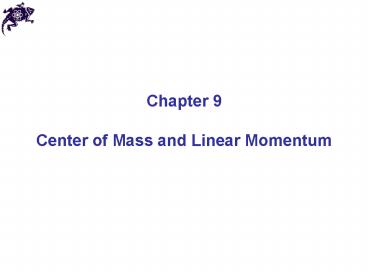Center of Mass and Linear Momentum - PowerPoint PPT Presentation
1 / 27
Title:
Center of Mass and Linear Momentum
Description:
Center of Mass and Linear Momentum – PowerPoint PPT presentation
Number of Views:46
Avg rating:3.0/5.0
Title: Center of Mass and Linear Momentum
1
Chapter 9 Center of Mass and Linear Momentum
2
- Linear momentum
- Linear momentum (or, simply momentum) of a
point-like object (particle) is - SI unit of linear momentum is kgm/s
- Momentum is a vector, its direction coincides
with the direction of velocity
3
- Newtons Second Law revisited
- Originally, Newton formulated his Second Law in
a more general form - The rate of change of the momentum of an object
is equal to the net force acting on the object - For a constant mass
4
- Center of mass
- In a certain reference frame we consider a
system of particles, each of which can be
described by a mass and a position vector - For this system we can define a center of mass
5
- Center of mass of two particles
- A system consists of two particles on the x axis
- Then the center of mass is
- Changing the reference frame
6
- Newtons Second Law for a system of particles
- For a system of particles, the center of mass is
- Then
7
- Newtons Second Law for a system of particles
- From the previous slide
- Here is a resultant force on particle i
- According to the Newtons Third Law, the forces
that particles of the system exert on each other
(internal forces) should cancel - Here is the net force of all external
forces that act on the system (assuming the mass
of the system does not change)
8
Newtons Second Law for a system of particles
9
- Linear momentum for a system of particles
- We define a total momentum of a system as
- Using the definition of the center of mass
- The linear momentum of a system of particles is
equal to the product of the total mass of the
system and the velocity of the center of mass
10
- Linear momentum for a system of particles
- Total momentum of a system
- Taking a time derivative
- Alternative form of the Newtons Second Law for
a system of particles
11
- Conservation of linear momentum
- From the Newtons Second Law
- If the net force acting on a system is zero,
then - If no net external force acts on a system of
particles, the total linear momentum of the
system is conserved (constant) - This rule applies independently to all components
12
- Center of mass of a rigid body
- For a system of individual particles we have
- For a rigid body (continuous assembly of matter)
with volume V and density ?(V) we generalize a
definition of a center of mass
13
Chapter 9 Problem 82
14
- Impulse
- During a collision, an object is acted upon by a
force exerted on it by other objects
participating in the collision - We define impulse as
- Then (momentum-impulse theorem)
15
- Elastic and inelastic collisions
- During a collision, the total linear momentum is
always conserved if the system is isolated (no
external force) - It may not necessarily apply to the total
kinetic energy - If the total kinetic energy is conserved during
the collision, then such a collision is called
elastic - If the total kinetic energy is not conserved
during the collision, then such a collision is
called inelastic - If the total kinetic energy loss during the
collision is a maximum (the objects stick
together), then such a collision is called
completely inelastic
16
Elastic collision in 1D
17
- Elastic collision in 1D stationary target
- Stationary target v2i 0
- Then
18
Chapter 9 Problem 58
19
Completely inelastic collision in 1D
20
Chapter 9 Problem 62
21
- Answers to the even-numbered problems
- Chapter 9
- Problem 2
- -1.50 m
- (b) -1.43 m
22
Answers to the even-numbered problems Chapter 9
Problem 10 6.2 m
23
Answers to the even-numbered problems Chapter 9
Problem 18 4.9 kg m/s
24
- Answers to the even-numbered problems
- Chapter 9
- Problem 26
- 42 N s
- (b) 2.1 kN
25
Answers to the even-numbered problems Chapter 9
Problem 46 3.1 102 m/s
26
- Answers to the even-numbered problems
- Chapter 9
- Problem 66
- (10 m/s)i (15 m/s)j
- (b) -500 J
27
- Answers to the even-numbered problems
- Chapter 9
- Problem 70
- 2.7
- (b) 7.4































